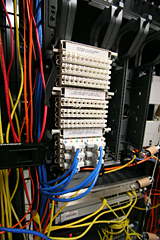Brave New Web
The Internet may seem like a limitless universe of websites, blogs and Facebook pages but it’s actually filling up. Eventually, if people keep adding websites and connecting computers, notebooks, tablets and mobile devices to the Internet, all 4.3 billion possible network addresses will be taken.
But don’t despair. Information technology experts are working on a fix that will essentially replace the current Internet with a shiny new version offering 340 undecillion addresses. Think of that as 340 trillion groups of one trillion networks each, with each network handling a trillion devices.
Making the Switch
To help the process along, some of the Web’s top sites voluntarily switched to the new Internet Protocol for 24 hours Wednesday, June 8. This test, called World IPv6 Day (for Internet Protocol version 6), helped identify issues that could cause problems when the new protocol is widely adopted.

Will Brockelsby (in the photo above), lead network architect at NC State, says the university was eager to be among a select group of public and private organizations that participated in World IPv6 Day.
“We wanted to be involved because NC State is so strong in technology and engineering,” he says. “It’s exciting to be on the forefront of technology.”
Nothing to See
Interestingly, the test didn’t affect Web browsing at NC State. Anyone who didn’t have Internet Protocol version 6 just saw the plain, old Internet.
Only a handful of NC State Web pages were tested with the new protocol, including the home page and the news section of the site. IPv6 versions of these pages were hosted on a proxy server under controlled conditions.
Other participants included Google, Yahoo, Facebook, YouTube, Comcast and Sprint.
- Categories:


